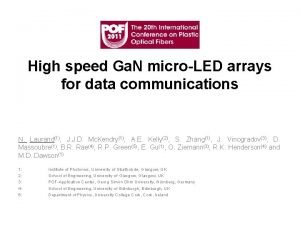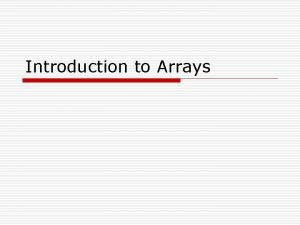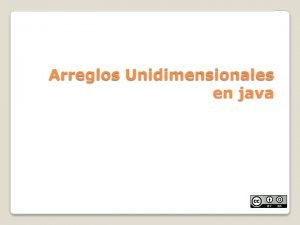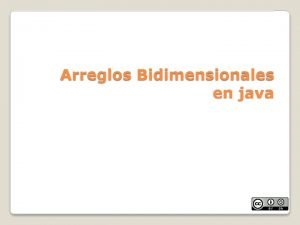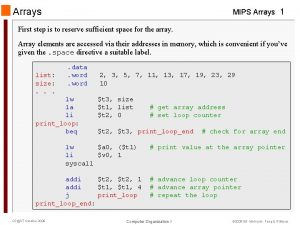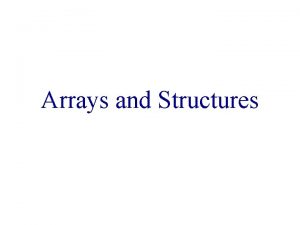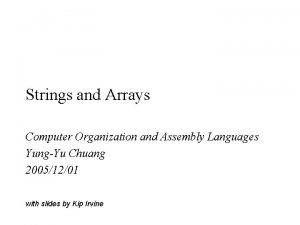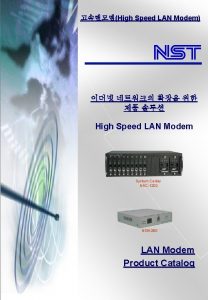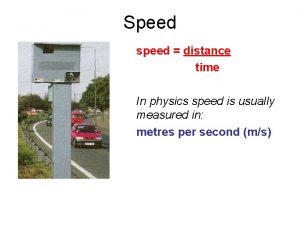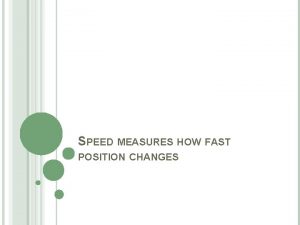High speed Ga N microLED arrays for data

















- Slides: 17

High speed Ga. N micro-LED arrays for data communications N. Laurand(1), J. J. D. Mc. Kendry(1), A. E. Kelly(2), S. Zhang(1), J. Vinogradov(3), D. Massoubre(1), B. R. Rae(4), R. P. Green(5), E. Gu(1), O. Ziemann(3), R. K. Henderson(4) and M. D. Dawson(1) 1: 2: 3: 4: 5: Institute of Photonics, University of Strathclyde, Glasgow, UK School of Engineering, University of Glasgow, UK POF-Application Center, Georg Simon Ohm University, Nürnberg, Germany School of Engineering, University of Edinburgh, UK Department of Physics, University College Cork, Ireland

Introduction to micro-LEDs 0. 5 mm Micro-stripes Matrix-addressable • III-nitride wafers grown on sapphire • UV (370 nm), violet (405 nm) blue (450 and 470 nm) and green (520 nm) • Patterned by standard photolithography M. D. Dawson and M. A. A. Neil, “Micro-pixellated LEDs for science and instrumentation” J Phys D. 41 090301 (2008).

Individually-addressable micro-LEDs 16 × 16 array • 72µm diameter • 100µm pitch • 370, 405, 450 nm emission 8 × 8 array • 10, 20… 80µm diameter • 200µm pitch • 370, 405, 450, 520, 560 nm emission

CW power output Diameter (nm) Maximum absolute power (m. W) 14 0. 48 24 0. 85 44 2. 52 64 3. 8 84 4. 94 • Up to 5 m. W from a single micro-LED pixel (450 nm peak emission) • Smaller pixels – higher output power densities & current densities

Micro-LEDs for communications • Our Ga. N-based micro-LEDs emit at wavelengths corresponding to attenuation minimum in POF • Data transmission using white LEDs also topical • Possible advantages of micro-LEDs? • faster response? • multi-channel output?

Visible-light communications using micro-LEDs

Bandwidth of micro-LEDs • ‘Bare’ pixels individually-addressed using a high-speed probe • Bandwidth strongly dependent on current density

Bandwidth of micro-LEDs • General trend that smaller micro-LEDs have higher maximum bandwidths. • Attributed to higher maximum current densities for smaller pixels (reduced current crowding and device self-heating).

Data transmission demo. • Single micro-LED addressed using high-speed probe. Emission imaged onto Si photodetector. • NRZ modulation (modulation depth 2 V, DC bias ~7 V).

Data transmission demo. 155 Mbit/s 622 Mbit/s 1. 2 Gbit/s • 520 nm-emitting micro-LED, diameter 34µm • i = 35 m. A, output power ≈ 0. 2 m. W • “Error-free” up to 1. 1 Gbit/s

Visible-light communications using CMOS-controlled micro. LEDs

CMOS-driver array • Primarily designed for generating intense (sub)ns-duration pulses for OSL pumping • 16× 16 array of individually-addressable drivers, 100× 100µm 2, 100µm pitch • Multiple modes of operation – CW, pulsed, NRZ modulation 1. 6 mm • Each of the 16 columns may be modulated with independent data inputs (MIMO data transmission) • CMOS and micro-LED chips integrated by flip-chip bonding process

Bandwidth of CMOS-micro-LEDs • NRZ signal from BERT used to trigger CMOS drivers. Micro-LEDs bias voltage modulated between 0 V and LED_VDD (variable) • Increasing V = higher bandwidth. Higher bandwidths obtained with smaller diameter pixels. Max bandwidth from single pixel ≈185 MHz (450 nm device) • ‘Error-free’ data transmitted at up to 512 Mbit/s (450 nm device)

Data transmission over POF • Work done in collaboration with O. Ziemann’s group, POF-AC, Nürnberg • 450 nm-emitting CMOS-controlled micro-LED device used • Micro-LED emission butt-coupled to 1 m of 1 mm diameter SI-POF • Passive equalisation, low-pass filter and electrical amplifier used

Data transmission over POF • Up to -3 d. Bm of coupled CW power • “Error-free” (BER ≤ 1× 10 -9) data transmission at 1 Gbit/s from pixel diameters ranging from 34 to 84µm • Error-free data transmission also achieved using 520 nm-device at up to 500 Mbit/s Received power (a. u. ) 84µm diameter pixel, 1 Gbit/s Time (0. 2 ns/div)

Multi-channel transmission • Existing CMOS device has up to 16 data inputs – potential MIMO transmitter for highthroughput parallel data transmission • Data transmission using two channels has been investigated. Using two 450 nm-emitting 34µm diameter pixels, error free parallel transmission has been achieved up to 600 Mbit/s (300 Mbit/s per channel) • Data rate per channel limited due to EMI issues between the two channels – this issue appears to be primarily caused by the design of the interface board, not the CMOS or micro-LED arrays themselves.

Conclusions • Micro-LED pixels have been shown to have modulation bandwidths of up to ~450 MHz, with peak emission at wavelengths suitable for transmission over POF. • >1 Gbit/s single pixel transmission demonstrated with no equalisation • CMOS control arrays have been shown to provide convenient control over micro-LED arrays, with bandwidth of up to 185 MHz possible. With up to 16 independent data channels, these devices are potential MIMO transmitters for VLC. Key Publications Jonathan Mc. Kendry, Richard P. Green, A. E. Kelly, Zheng Gong, Benoit Guilhabert, David Massoubre, Erdan Gu and Martin D. Dawson “High Speed Visible Light Communications Using Individual Pixels in a Micro Light-Emitting Diode Array” Photon. Tech. Lett. , Vol 22, No. 18, pp 1346 -1348, Sept 2010. Mc. Kendry, J. J. D. ; Massoubre, D. ; Zhang, S. ; Rae, B. R. ; Green, R. P. ; Gu, E. ; Henderson, R. K. ; Kelly, A. E. ; Dawson, M. D. ; , "Visible-Light Communications Using a CMOS-Controlled Micro-Light- Emitting-Diode Array, " Lightwave Technology, Journal of , vol. 30, no. 1, pp. 61 -67, Jan. 1, 2012
 Microled arrays
Microled arrays Coping with emotions while driving includes
Coping with emotions while driving includes Array advantage and disadvantage
Array advantage and disadvantage Parallel arrays
Parallel arrays Speed time and distance formula
Speed time and distance formula Speed detection of moving vehicle using speed cameras ppt
Speed detection of moving vehicle using speed cameras ppt Array of arrays c++
Array of arrays c++ Ragged array
Ragged array 潘仁義
潘仁義 Parallel arrays
Parallel arrays Why do we need arrays?
Why do we need arrays? Dynamic arrays and amortized analysis
Dynamic arrays and amortized analysis Arrays unidimensionales java
Arrays unidimensionales java Arreglos bidimensionales en java
Arreglos bidimensionales en java Mips array example
Mips array example Polynomial representation using array in c
Polynomial representation using array in c Strings in assembly language
Strings in assembly language Global arrays in c
Global arrays in c
